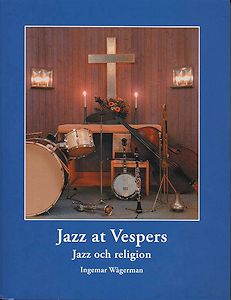[
Note: The print version of this book is in Swedish only, but
for the convenience of non-Swedish speakers there is a CD .pdf version,
containing both English and Swedish texts, available singly. The CD
contains all of the content of the printed version, including photographs
and illustrations (some in colour), but there may be some variation
in the pagination of the two versions, thus affecting the index, which
is keyed to the print version. Also it should be noted that the author,
Ingemar Wĺgerman, provided the English translation, and he states that
his “literal translation is not [always] idiomatically correct.” There
are, indeed, some such errors of idiom, but they are minor, none actually
impeding communication.]
350 SEK (book and CD), 200 SEK (CD
only); prices include postage.
Exploring the relationship between jazz and religion would be an ambitious, even immense, undertaking, given the breadth of these two subjects; it would
involve countless hours of research of both primary and secondary sources; and it would result in several volumes. So Wĺgerman, who hails from Sweden and
is the pianist and leader of a New Orleans-style jazz band called the Göta River Jazzmen, sensibly restricts it for the most part to the relationship
between traditional (i.e, early) jazz and religion, mainly Christianity, eschewing the more modern forms of jazz and non-Christian
religions other than to give them a passing consideration.
His account centers on what Wĺgerman considers the defining event in the relationship of jazz and religion—the George Lewis band’s performance at Holy
Trinity Episcopal Church, Oxford, Ohio, on Mar. 22, 1953, where for perhaps the first time the music of an entire church service was provided by a jazz
band. The following year this event was repeated and recorded, resulting in the Lewis band album “Jazz at Vespers,” which the author adopts as his title
for this treatise.
Wĺgerman begins by tracing the development of the gospels, spirituals, and blues in the music of the Christian church in the United States, particularly
that of the Baptist and Pentecostal denominations, from the early 19th century up to the traditional jazz “revival” that occurred ca. 1940. He
discusses the opposition to jazz music in the first half of the 20th century by many in the church as well as the acceptance, albeit limited, by
others, and he assiduously pursues every recording he can locate which gives evidence of jazz bands’ playing music usually found only in church, such as
the Morgan band’s 1927 seminal recordings of “Sing On,” “Down by the Riverside,” and “Over in the Gloryland.” He also quotes extensively what musicians had
to say about the subject, and he gives the same close attention to the jazz recordings issued during the revival period and from then to the present.
Not limiting the scope to the U.S. only, he considers the traditional jazz being played elsewhere, especially the U.K. and Europe, devoting a fair amount
of space to his native Sweden, as one might expect. Perhaps this section will be of least appeal to non-Swedes as they will have little familiarity with
the musical milieu in that part of the world.
Wĺgerman’s observations about the relationship of religion and jazz are often provocative: for instance, traditional jazz musicians do not, for the most
part, compose new songs in the idiom but adopt those already extant—gospels, spirituals, hymns—and “jazz” them; whereas more modern jazz musicians, such as
Ellington, Mingus, Brubeck, compose new works with a religious subject. (It might also be added that the author believes that the influence of
non-Christian religions, such as Islam or Buddhism, on jazz is minor and mainly to be found in “modern” jazz.) Another interesting tenet he advances is
that brass bands played an important part in bringing jazz and religion together. He examines both the European and West African roots of the New Orleans
brass bands, noting how these became manifest in the New Orleans funeral. From the European came the funereal dirge on the way to the cemetery; from the
West African came the singing and dancing following the interment that became the second line. In turn the music flowed both ways, religious pieces such as
“Just a Closer Walk” being included in bands’ repertoires on secular occasions, and profane pieces such as “I’ll be Glad When You’re Dead” being played as
the bands stomped their way back from the cemetery.
As stated above, much of the book centers on the importance of the role the revivalists, such as Bunk Johnson and George Lewis, played in influencing the
adoption of religious songs into jazz and the acceptance of jazz into the liturgy of the church, and Wĺgerman provides an illuminating analysis of it.
The book also provides an exhaustive list of tunes—and often their lyrics—that comprise this repertoire, with an extended analysis of one of his favorites,
“Lily of the Valley,” and another of that jazz anthem “When the Saint Go Marching In.” Another list supplies data on albums of religious-oriented
traditional jazz. (Band leaders or musical directors would undoubtedly find this section of the book of considerable utility.) Finally, there is an
extensive bibliography appended. All of this attests to the painstaking research Wĺgerman conducted, resulting in a book that, while not being perhaps
definitive in every area, is very enlightening and persuasive on the whole subject of the relationship of jazz and religion.
One can obtain more information at the web site www.jazzhistoria.se or by e-mail from jazzhistoria@gmail.com.
Bert Thompson
